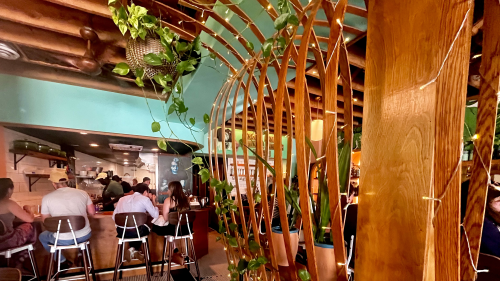We attended Downtown Madison Inc.'s (DMI) monthly “What’s Up Downtown?” series to give you the inside scoop on major programs, projects, and initiatives impacting downtown Madison.
This month’s topic? The past, present, and future of State Street.
Speakers included:
- Ed Freer | Landscape Architecture, Senior Landscape Architect at GRAEF
- Satya Rhodes-Conway | City of Madison Mayor
- Mary Lang Sollinger | Former State Street retailer and Downtown Coordinating Committee Chair
- Cindy Torstveit | Associate Vice Chancellor for Facilities Planning & Management at UW-Madison
Ed Freer
“I moved here because of State Street,” says Freer, who spoke on the importance of creating public spaces in urban areas. He’s currently working on the upcoming Picnic Point Outreach Center, as well as with Sasaki as a consultant on the Lake Monona waterfront redesign project.

The future of Lake Monona’s waterfront. | Rendering via Sasaki
He is optimistic about the future of State Street, specifically the prospect of a pedestrian mall that is getting a test trial this summer. With an influx of new developments on and around State Street, Freer explained how important the proportions are when rethinking State Street. “Whether the building is three stories or 10 stories, it doesn’t matter. It’s the bottom two stories that matter,” since that’s where all the action happens.
While Freer recognizes that new trends are important to keep in mind when designing a public space — green infrastructure, street art, and multipurpose elements — he also considers longevity, “what will it look like 400 years from now?”
Mayor Satya Rhodes-Conway
The mayor reminisced about times spent as a youngster at Ithica Commons in New York, where she grew up. She hopes that Madison can offer a similar positive experience, “we need to make sure that [high school and middle school] students feel comfortable coming to State Street.”
When asked how she envisions the future of State Street, Rhodes-Conway emphasized the importance of filling storefronts, “even if they are filled temporarily ... we need to make sure we’re bringing that vibrancy.”
Cindy Torstveit
State Street, Torstveit noted, serves as a connection between campus and the community, both literally and figuratively. Stretching from Bascom Hill directly to Capitol Square, it serves as an overlap area where professionals take a lunch break as students rush by on their way to class.
When asked about what is needed to enhance State Street in the future, Torstveit touched on accessibility and safety noting that “a lot of our classes are at night, and the libraries are open very late.”
UW-Madison’s new Campus Framework Plan is in the works for 2025. The university aims to work with the city and community to make sure State Street is a place where the campus and community can coexist harmoniously.

The experimental pedestrian mall will span the 400-600 blocks of State Street. | Rendering via City of Madison
Mary Lang Sollinger
Sollinger owned The Peacock clothing boutique on State Street from 1968-1996. When asked how she’s seen things evolve over the last decades, she said, “State Street was a place to experiment with, take a chance with ... and it still is I think.”
Since State Street is such an integral part of Madison’s identity, she believes, it draws a diverse crowd ranging from locals and students to out-of-town athletes and business people. “It’s really unique, and we take it for granted.”
What’s next?
Later this summer, DMI and the City of Madison will be working on the first public/private strategic visioning plan for State Street and downtown. The goal is to look at what the area will look like in terms of storefronts, programs, and aesthetics.
Funds are being raised by DMI to create the strategy and bring these visions to fruition while the city has committed resources — Think: parking garages, housing, business support — and the Commercial Ownership Assistance Program — to make State Street a destination for the city, state, and country.











